名词的数和所有格
- 格式:doc
- 大小:39.00 KB
- 文档页数:3
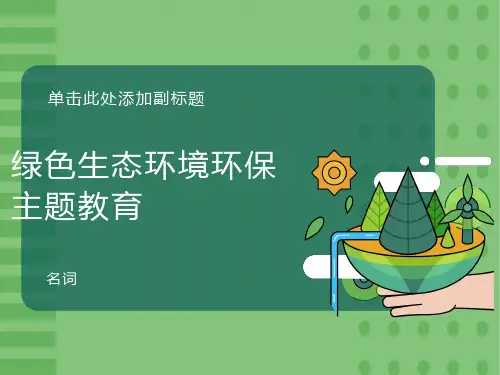

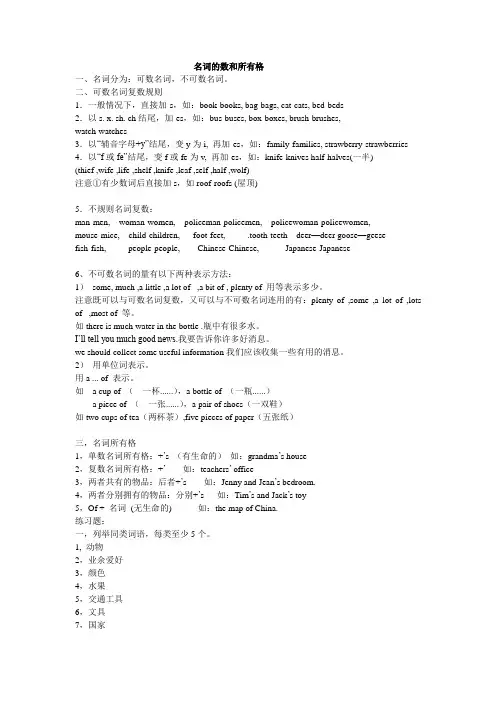
名词的数和所有格一、名词分为:可数名词,不可数名词。
二、可数名词复数规则1.一般情况下,直接加-s,如:book-books, bag-bags, cat-cats, bed-beds2.以s. x. sh. ch结尾,加-es,如:bus-buses, box-boxes, brush-brushes,watch-watches3.以“辅音字母+y”结尾,变y为i, 再加-es,如:family-families, strawberry-strawberries 4.以“f或fe”结尾,变f或fe为v, 再加-es,如:knife-knives half-halves(一半)(thief ,wife ,life ,shelf ,knife ,leaf ,self ,half ,wolf)注意①有少数词后直接加s,如roof-roofs (屋顶)5.不规则名词复数:man-men, woman-women, policeman-policemen, policewoman-policewomen,mouse-mice, child-children, foot-feet, .tooth-teeth deer—deer goose—geesefish-fish, people-people, Chinese-Chinese, Japanese-Japanese6、不可数名词的量有以下两种表示方法:1)some, much ,a little ,a lot of ,a bit of , plenty of 用等表示多少。
注意既可以与可数名词复数,又可以与不可数名词连用的有:plenty of ,some ,a lot of ,lots of ,most of 等。
如there is much water in the bottle .瓶中有很多水。
I’ll tell you much good news.我要告诉你许多好消息。

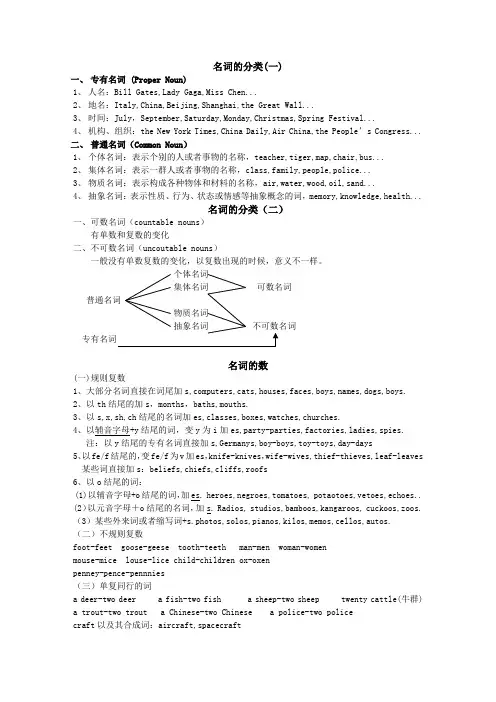
名词的分类(一)一、专有名词 (Proper Noun)1、人名:Bill Gates,Lady Gaga,Miss Chen...2、地名:Italy,China,Beijing,Shanghai,the Great Wall...3、时间:July,September,Saturday,Monday,Christmas,Spring Festival...4、机构、组织:the New York Times,China Daily,Air China,the People’s Congress...二、普通名词(Common Noun)1、个体名词:表示个别的人或者事物的名称,teacher,tiger,map,chair,bus...2、集体名词:表示一群人或者事物的名称,class,family,people,police...3、物质名词:表示构成各种物体和材料的名称,air,water,wood,oil,sand...4、抽象名词:表示性质、行为、状态或情感等抽象概念的词,memory,knowledge,health...名词的分类(二)一、可数名词(countable nouns)有单数和复数的变化二、不可数名词(uncoutable nouns)一般没有单数复数的变化,以复数出现的时候,意义不一样。
名词的数(一)规则复数1、大部分名词直接在词尾加s,computers,cats,houses,faces,boys,names,dogs,boys.2、以th结尾的加s,months,baths,mouths.3、以s,x,sh,ch结尾的名词加es,classes,boxes,watches,churches.4、以辅音字母+y结尾的词,变y为i加es,party-parties,factories,ladies,spies.注:以y结尾的专有名词直接加s,Germanys,boy-boys,toy-toys,day-days5、以fe/f结尾的,变fe/f为v加es,knife-knives,wife-wives,thief-thieves,leaf-leaves某些词直接加s:beliefs,chiefs,cliffs,roofs6、以o结尾的词:(1)以辅音字母+o结尾的词,加es. heroes,negroes,tomatoes, potaotoes,vetoes,echoes.. (2)以元音字母+o结尾的名词,加s. Radios, studios,bamboos,kangaroos, cuckoos,zoos. (3)某些外来词或者缩写词+s.photos,solos,pianos,kilos,memos,cellos,autos.(二)不规则复数foot-feet goose-geese tooth-teeth man-men woman-womenmouse-mice louse-lice child-children ox-oxenpenney-pence-pennnies(三)单复同行的词a deer-two deer a fish-two fish a sheep-two sheep twenty cattle(牛群) a trout-two trout a Chinese-two Chinese a police-two policecraft以及其合成词:aircraft,spacecraft这些名词通常以复数形式出现,works,means,series,species,barracks,headquarters,goods (四)集体名词的数通常只作复数的集体名词:people,cattle,police通常只作单数的集体名词:machinery,furniture,mankind,jewellery,clothing,equipment 既可以作单数又可以作复数的词,单数强调整体,复数强调个体成员.Class,school,crowd,army,family,party,public,world,team,enemy,government,group. Eg:The class is big. The class are all busy.(五)不可数名词的数.中学常见的不可数名词:advice,fun,news,information,progress,baggage,luggage,furniture,equipment,luck,traf fic,weather,wood,work,homework,housework,cloth,bread,fruit.(六)不定量词对名词的修饰只修饰可数的:many,few,a number of只修饰不可数的:much,little,a large amount of,a great deal of两者都可以修饰的:some,any,plenty of,a lot of,a large quantity of单位词(partitive)单位词:又叫单位名词,是表示物体个体性的词,英语中的可数名词与单位词搭配表示一群、一帮等含义,不可数名词一般没有单复之分,不以个数计算,对这类名词计数也得用单位词。
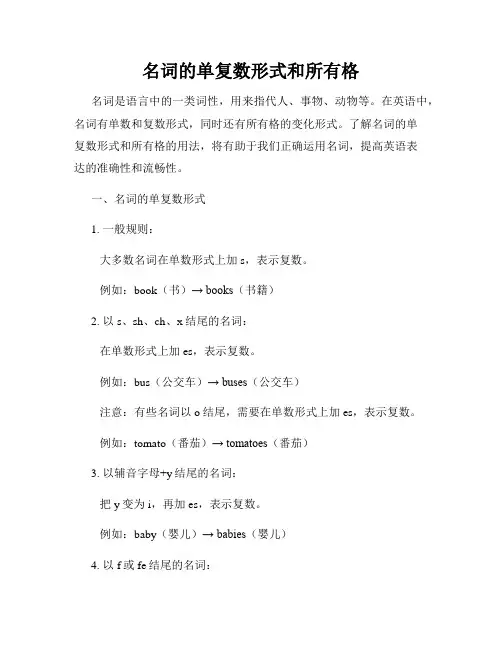
名词的单复数形式和所有格名词是语言中的一类词性,用来指代人、事物、动物等。
在英语中,名词有单数和复数形式,同时还有所有格的变化形式。
了解名词的单复数形式和所有格的用法,将有助于我们正确运用名词,提高英语表达的准确性和流畅性。
一、名词的单复数形式1. 一般规则:大多数名词在单数形式上加s,表示复数。
例如:book(书)→ books(书籍)2. 以s、sh、ch、x结尾的名词:在单数形式上加es,表示复数。
例如:bus(公交车)→ buses(公交车)注意:有些名词以o结尾,需要在单数形式上加es,表示复数。
例如:tomato(番茄)→ tomatoes(番茄)3. 以辅音字母+y结尾的名词:把y变为i,再加es,表示复数。
例如:baby(婴儿)→ babies(婴儿)4. 以f或fe结尾的名词:把f或fe变为v,再加es,表示复数。
例如:leaf(叶子)→ leaves(叶子)5. 有不规则变化的名词:一些名词没有明确的规律,需要记住它们的单复数形式。
例如:man(男人)→ men(男人)woman(女人)→ women(女人)二、名词的所有格名词的所有格用来表示所属关系或归属关系。
在英语中,一般在名词的后面加上's来表示所有格。
1. 单数名词的所有格:例如:cat(猫)→ cat's(猫的)2. 复数名词的所有格:一般在复数名词的后面加上'来表示所有格,不加s。
例如:cats(猫)→ cats'(猫的)3. 以s结尾的复数名词的所有格:在复数名词的后面加上's来表示所有格。
例如:students(学生)→ students'(学生的)4. 以s、sh、ch、x等结尾的复数名词的所有格:在复数名词的后面直接加上',不加s。
例如:buses(公交车)→ buses'(公交车的)5. 以辅音字母+y结尾的复数名词的所有格:把y变为i,再加es',表示所有格。
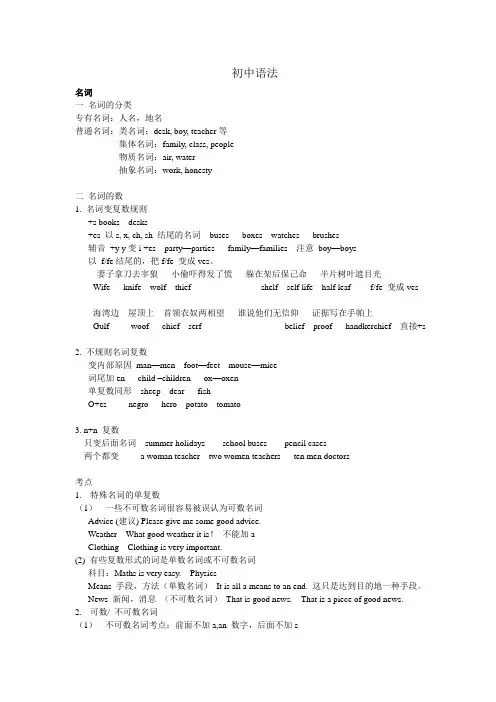
初中语法名词一名词的分类专有名词:人名,地名普通名词:类名词:desk, boy, teacher等集体名词:family, class, people物质名词:air, water抽象名词:work, honesty二名词的数1. 名词变复数规则+s books desks+es 以s, x, ch, sh 结尾的名词buses boxes watches brushes辅音+y y变i +es party—parties family—families 注意boy—boys以f/fe结尾的,把f/fe 变成ves。
妻子拿刀去宰狼小偷吓得发了慌躲在架后保己命半片树叶遮目光Wife knife wolf thief shelf self life half leaf --- f/fe 变成ves海湾边屋顶上首领农奴两相望谁说他们无信仰证据写在手帕上Gulf woof chief serf belief proof handkerchief 直接+s2. 不规则名词复数变内部原因man—men foot—feet mouse—mice词尾加en child –children ox—oxen单复数同形sheep dear fishO+es negro hero potato tomato3. n+n 复数只变后面名词summer holidays school buses pencil cases两个都变 a woman teacher two women teachers ten men doctors考点1.特殊名词的单复数(1)一些不可数名词很容易被误认为可数名词Advice (建议) Please give me some good advice.Weather What good weather it is!不能加aClothing Clothing is very important.(2) 有些复数形式的词是单数名词或不可数名词科目:Maths is very easy. PhysicsMeans 手段,方法(单数名词)It is all a means to an end. 这只是达到目的地一种手段。
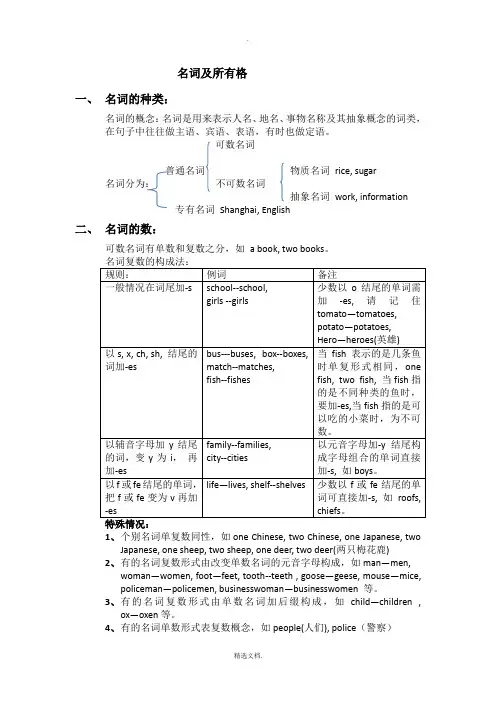
名词及所有格一、名词的种类:名词的概念:名词是用来表示人名、地名、事物名称及其抽象概念的词类,在句子中往往做主语、宾语、表语,有时也做定语。
可数名词普通名词物质名词rice, sugar 名词分为:不可数名词抽象名词work, information专有名词Shanghai, English二、名词的数:可数名词有单数和复数之分,如 a book, two books。
1、个别名词单复数同性,如one Chinese, two Chinese, one Japanese, twoJapanese, one sheep, two sheep, one deer, two deer(两只梅花鹿)2、有的名词复数形式由改变单数名词的元音字母构成,如man—men,woman—women, foot—feet, tooth--teeth , goose—geese, mouse—mice,policeman—policemen, businesswoman—businesswomen 等。
3、有的名词复数形式由单数名词加后缀构成,如child—children ,ox—oxen等。
4、有的名词单数形式表复数概念,如people(人们), police(警察)三、不可数名词及其数量的表示1.不可数名词没有复数形式,但paper 在作为报纸或讲义解释时为可数名词,news(消息)尽管以-s,结尾,实为不可数名词。
2.不可数名词可以用量词来修饰,如a piece of paper/news/ bread/meat a glass of milk/watera cup of tea a bottle of inktwo loaves of bread some advicea little work a lot of homework四、专有名词专有名词是表示具体的人名、地名或事物、机构等名称,通常第一个字母大写,且多不加冠词,但由普通名词构成的专有名词除外。
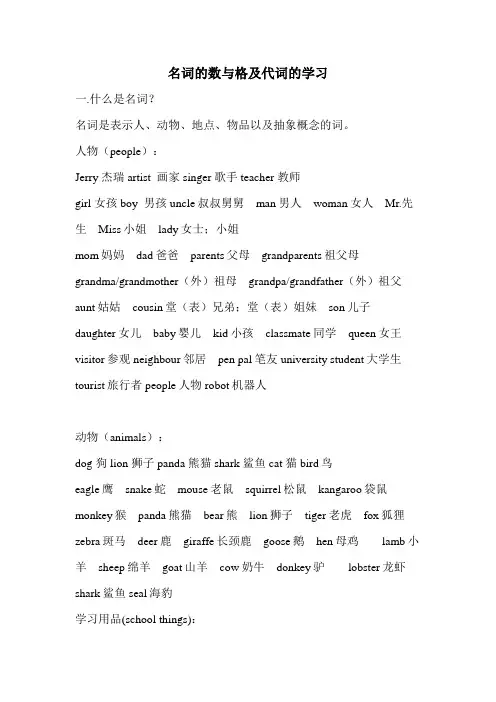
名词的数与格及代词的学习一.什么是名词?名词是表示人、动物、地点、物品以及抽象概念的词。
人物(people):Jerry 杰瑞artist 画家singer 歌手 teacher 教师girl 女孩boy 男孩uncle叔叔舅舅man男人woman女人Mr.先生Miss小姐lady女士;小姐mom妈妈dad爸爸parents父母grandparents祖父母grandma/grandmother(外)祖母grandpa/grandfather(外)祖父aunt姑姑cousin堂(表)兄弟;堂(表)姐妹son儿子daughter女儿baby婴儿kid小孩classmate同学queen女王visitor参观neighbour邻居pen pal笔友university student大学生tourist旅行者people人物robot机器人动物(animals):dog 狗 lion 狮子panda 熊猫 shark 鲨鱼 cat 猫bird鸟eagle鹰snake蛇mouse老鼠squirrel松鼠kangaroo袋鼠monkey猴panda熊猫bear熊lion狮子tiger老虎fox狐狸zebra斑马deer鹿giraffe长颈鹿goose鹅hen母鸡lamb小羊sheep绵羊goat山羊cow奶牛donkey驴lobster龙虾shark鲨鱼seal海豹学习用品(school things):pen钢笔pencil铅笔pencil-case铅笔盒ruler尺子book书bag 包comic book漫画书post card明信片newspaper报纸schoolbag书包eraser橡皮crayon蜡笔sharpener卷笔刀story-book故事书notebook笔记本Chinese book语文书English book 英语书math book数学书magazine杂志dictionary词典人体(body):foot脚head头face脸hair头发nose鼻子mouth嘴eye眼睛ear耳朵arm手臂hand手finger手指leg腿tail尾巴颜色(colours):red红blue蓝yellow黄green绿white白black黑pink粉红purple紫orange橙brown棕职业(jobs):teacher教师student学生doctor医生nurse护士driver司机farmer农民singer歌唱家writer作家actor男演员actress女演员artist画家TV reporter电视台记者engineer工程师policeman(男)警察cleaner清洁工baseball player棒球运动员police警察食品、饮料(food & drink):rice米饭bread面包beef牛肉milk牛奶water水egg蛋fish 鱼tofu豆腐cake蛋糕hot dog热狗hamburger汉堡包Frenchfries炸薯条cookie曲奇biscuit饼干jam果酱noodles面条meat肉chicken鸡肉pork猪肉mutton羊肉vegetable蔬菜salad沙拉soup汤ice冰ice-cream冰淇淋Coke可乐juice果汁tea茶coffee咖啡breakfast早餐lunch午餐dinner/supper 晚餐meal一餐蔬菜(Vegetables):Cabbage 卷心菜Potato 马铃薯Sweet potato红薯(红苕)Carrot 胡萝卜Tomato 蕃茄Eggplant 茄子Celery 芹菜Lotus root 莲藕Sweet corn 玉米Garlic 大蒜Ginger(root)姜Leeks 韭菜Green Pepper 青椒Cucumber黄瓜Pea豌豆Lettuce 生菜水果(fruits):apple苹果peach桃子Lemon 柠檬Pear 梨子Banana 香蕉Grape 葡萄raisins葡萄干plum 李子honeydew(melon)哈密瓜orange 橙子Golden apple 黄绿苹果、脆甜Strawberry 草莓Mango 芒果fig 无花果pineapple 菠萝loquat 枇杷Cherry 樱桃watermelon西瓜lime 酸橙Dates 枣子地点:airport 机场 park 公园 school 学校 library 图书馆 beach抽象概念:wish 愿望 peace 和平 war 战争二.可数名词与不可数名词名词根据是否能够用数字来计算,可以分为可数名词和不可数名词两类。
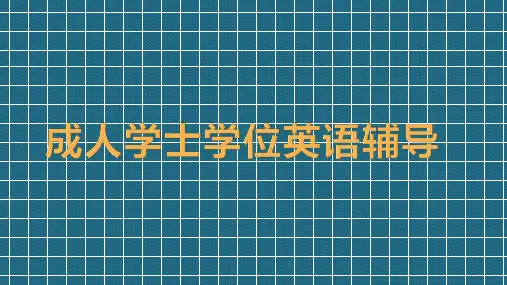

第二章名词的数与格一.名词的数1.个体名词的数:指名词的原形,前可加不定冠词或基数词。
复数有规则复数和不规则复数2.集体名词的数:集体名词有的能计数,有的不能。
有的本身没有复数形式,如要计数,就要用语义上与之对应的个体名词集体名词个体名词foliage leafequipment toolcorrespondence letterpolice policemanclergy clergymanmachinery machinepoetry poemcutlery knifeweaponry gunluggage bag3.物质名词的数:物质名词一般不可数。
没有单,复数之分。
有些以复数出现,但意义不同sand---sands 大面积的沙滩food---foods 指多种食品water---waters 大面积的水域coffee--- two coffees 两杯咖啡有些名词既可作物质名词,也可作个体名词stone: 石料;石头egg: 蛋白;鸡蛋lamb: 羔羊肉;羔羊onion: 洋葱味;洋葱rubber: 橡胶;胶鞋4.抽象名词的数:有些抽象名词表示抽象概念时是不可数名词,而表示具体事物则是可数名词relation: 关系;亲属youth: 青年,青春;小伙子,男青年business: 商业,交易;商店distraction: 心不在焉;烦恼的事有些抽象名词本身没有复数形式,如计数就用在语义上与之对应的个体名词抽象名词个体名词laughter laughphotography photowork jobpermission permitfun joyhomework exercisemusic song有些抽象名词单/ 复表示不同的意义如:experience: 经验(没有复数);经历(单/ 复数)有些名词在固定搭配中可以表示抽象概念,成为不可数have too much winter = a too long spell of cold weatherhave too little ear = to be not inclined to listen to othershave too much mouth = talk too muchhave room for = have a need for5.专有名词的数:专有名词一般没有复数形式,除非本身有复数词缀。
名词名词的数:可数名词与不可数名词一、不可数名词,初中阶段常见的不可数名词有:w ater ; meat ; rice ; bread ; milk ; tea ; orange(桔汁) ; fruit ; air ; snow ; chalk; work ; paper(纸) ; time(时间); music ; weather ; grass ; news ; food ; fish(鱼肉); coke ; porridge ; cake(可数或不可数).不可数名词应注意以下几点:1)前无数、冠,后无复数;作主语为单三.2)表量用约数some /any , much ;little, a little, a lot of 或用of短语二、可数名词的复数A、不规则变化:man—men ; woman—women ;child—children ,foot—feettooth—teeth mouse(鼠)—mice单复同形: fish ; sheep ; deer ; Chinese ; Japanesepeople , police, cattle本身就表示复数概念,后面的谓语动词要用复数三、名词所有格:名词’s (意思是“……的”)1.有生命的名词所有格,一般在后加“’s”,表两者共有则在后者加“’s”Lucy and Lily’s father L ucy’s and Lily’s father2.以“s或es”结尾的复数名词只加“ ’ ”,以“s”结尾的单数名词或人名后加“’s”3.表示时间、距离、国家、城市、团体、机构等名词,也可以加“’s”构成所有格。
4.无生命的名词所有格用of来引导eg. the leg of the desk5.双重所有格:“of+名词’s”或“of+名词性物主代词”eg a friend of my father’s a friend of mine四、名词作定语1.名词作定语,一般用单数形式,个别情况也用复数形式。
名词复数和名词所有格一名词复数的规则变化1.一般情况加-s map--maps bag-bags car-cars2.以s, sh, ch, x等结尾加–es bus-buses watch-watches3.以辅音字母+y结尾变y 为i再加es 、baby---babies4. 以o 结尾的名词,变复数时:a. 加s,如:photo---photos piano---pianos radio---radios zoo---zoos;b. 加es,如:potato--potatoes tomato--tomatoes hero—heroes5. 以f或fe 结尾的名词去f,fe 加ves,half---halves knife---knives leaf---leaves wolf---wolves thief---thieves;二名词复数的不规则变化1.child—children foot—feet tooth—teeth mouse—miceman---men woman---women注意:由一个词加man 或woman构成的合成词,其复数形式也是-men 和-women,如an Englishman,two Englishmen。
但German不是合成词,故复数形式为Germans;2. 单复同形,如deer,sheep,fish,Chinese,Japanese等。
英镑、法郎等都有复数形式。
如:a dollar, two dollars; a meter, two meters。
3.集体名词,以单数形式出现,但实为复数。
例如:people police等本身就是复数,不能说a people,a police,4.以s结尾,仍为单数的名词,如:a. maths,politics,physics等学科名词,一般是不可数名词,为单数。
b. news 为不可数名词。
5. 表示由两部分构成的东西,如:glasses (眼镜)trousers,clothes等,若表达具体数目,要借助数量词pair(对,双);a pair of glasses; two pairs of trousers等。
Lesson One 名词的单复数和所有格Part A Grammar Review Array名词名词是人们认识事物所使用的基本词汇,它主要用来指人或各种事物具体的名称,也可以指抽象的概念。
根据名词所指事物是否可数,即是否可分成独立一致的多个个体,可以将名词分成可数名词和不可数名词。
一、可数名词可数名词有单数和复数两种形式。
单数名词变复数名词的变化规则分为规则变化和不规则变化两种。
(一)规则变化如下:妻子(wife)持刀(knife)去宰狼(wolf),小偷(thief)吓得发了慌;躲在架(shelf)后保己(self)命(life),半片(half)树叶(leaf)遮目光。
(二)不规则变化有下面几种情形:①man – men;woman – women(男人、女人,a变e);②foot – feet;tooth – teeth;goose – geese (牙齿和鹅、脚,oo变ee);③单复数形式一样的单词有:sheep, deer, fish等;④表示某个国人的词:Chinese, Japanese单复数一致;英法一律a改e:Englishman-Englishmen, Frenchman-Frenchmen其他国家加s:American-Americans,German- Germans⑤复合名词把中心词变为复数:girl student(女学生)- girl students(学生是中心词);pencil-box –;apple tree - 等。
⑥包含man和woman构成的复合词,两个词全都变成复数:man doctor – men doctors;woman teacher –等。
⑦完全不讲道理的变化:mouse – mice;child – children;datum – data等。
⑧只有复数形式的名词:pants; clothes; trousers; goods; glasses; scissors; compasses;shoes; socks等词只有复数形式。
名词及所有格一、名词的种类:名词的概念:名词是用来表示人名、地名、事物名称及其抽象概念的词类,在句子中往往做主语、宾语、表语,有时也做定语。
可数名词普通名词物质名词rice, sugar 名词分为:不可数名词抽象名词work, information专有名词Shanghai, English二、名词的数:可数名词有单数和复数之分,如 a book, two books。
1、个别名词单复数同性,如one Chinese, two Chinese, one Japanese, twoJapanese, one sheep, two sheep, one deer, two deer(两只梅花鹿)2、有的名词复数形式由改变单数名词的元音字母构成,如man—men,woman—women, foot—feet, tooth--teeth , goose—geese, mouse—mice,policeman—policemen, businesswoman—businesswomen 等。
3、有的名词复数形式由单数名词加后缀构成,如child—children ,ox—oxen等。
4、有的名词单数形式表复数概念,如people(人们), police(警察)三、不可数名词及其数量的表示1.不可数名词没有复数形式,但paper 在作为报纸或讲义解释时为可数名词,news(消息)尽管以-s,结尾,实为不可数名词。
2.不可数名词可以用量词来修饰,如a piece of paper/news/ bread/meat a glass of milk/watera cup of tea a bottle of inktwo loaves of bread some advicea little work a lot of homework四、专有名词专有名词是表示具体的人名、地名或事物、机构等名称,通常第一个字母大写,且多不加冠词,但由普通名词构成的专有名词除外。
一、名词的数1.单数和复数可数名词有单数和复数两种形式。
复数形式通常是在单数形式后加词尾“-s”构成,其主要变法如下:规则变化:(1)一般情况在词尾加-s,例如:book→books,girl→girls,boy→boys,pen→pens,doctor→doctors, boy→boys。
(2)以s,x,ch,sh,结尾的词加-es,例如:bus→buses,class→classes,box→boxes,watch→watches,brush→brushes。
(4)以辅音母加y结尾的词变“y”为“i”再加-es,例如:city→cities, factory→factories, country→countries, family→families。
但要注意的是以元音字母加y结尾的名词的复数形式只加s,如:boy→boys,day→days。
(5)以o结尾的词多数都加-es。
例如:hero→heroes,potato→potatoes,tomato→tomatoes (6)以f或fe结尾的词,多数变f为v再加-es,例如:knife→knives,leaf→leaves,half→halves。
不规则变化:例如:man→men,woman→women,tooth→teeth,foot→feet,child→children,mouse→mice。
2.不可数名词“量”的表示方法a cup of tea → two cups of teaa piece of paper → four pieces of papera bottle of milk → five bottles of milk随堂练习一.写出下列单词的复数形式boy______ peach________ knife_________ child____________ woman________ tooth________ bus___________ baby_____________fox__________ dish_________ tomato________ hero_____________ 二.用所给单词的正确形式填空1.Give me two_________(glass) of milk, please.2.How many ___________(people)are there in your family.3.How many ____________(watch) are there in your shop.4.Where are the ____________(mouse) ?5.Those_____________(pair) of shoes for your mother.二、名词的所有格名词所有格,用来表示人或物的所有,表示所属关系。
1. 不以s结尾的名词的所有格直接加's,例如:a student's room, students' rooms, father's shoes。
2. 在表示时间、距离、长度、重量等名词,以s结尾的所有格要用'例如:a twenty minutes' walk,ten miles' journey,a boat's length,two pounds' weight,3. 无生命名词的所有格则必须用of结构,例如:a map of China,the end of this term,the capital of our country, the color of the flowers。
5. “of + 名词所有格”称为双重所有格例如:a friend of my father's【注意】如果两个名词并列,并且分别有's,则表示“分别有”,例如:John's and Mary's rooms (约翰和玛丽各有一间,共两间);Tom's and Mary's bikes(两人各自的自行车)。
两个名词并列,只有一个's,则表示“共有”,例如:John and Mary's room(约翰和玛丽共有一间);Tom and Mary's mother(即Tom与Mary是兄妹)。
【实例解析】1.(中考试题)These _________ have saved many children’s lives.A. woman doctorsB. women doctorC. women doctorsD. woman doctor2. (中考试题)This is _________ bedroom. The twin sisters like it very much.A. Anne and JaneB. Anne’s and Jane’sC. Anne’s and JaneD. Anne and Jane’s3. (中考试题)---Are there any ________ on the farm?---Yes, there are some.A. horseB. duckC. chickenD. sheep4. (中考试题)---What would you like to drink, ________ or orange?---Orange, please.A. hamburgerB. fishC. tea【中考演练】一. 单项填空1.--- Where have you been, Tim?--- I’ve been to ______.A. the Henry houseB. the Henry familyC. The Henry’s homeD. Henry’s2.--- They are thirsty. Will you please give them ______ ?--- Certainly.A. some bottles of watersB. some bottles of waterC. some bottle of waterD. some bottle of waters3.Mike hurt one of his ______ in the accident yesterday.A. toothB. feetC. handD. ear4.The______ has two _______ .A. boys; watchesB. boy; watchC. boy; watchesD. boys; watch5.The little baby has two _______ already.A. toothB. toothsC. teethD. teeths6.--- It’s dangerous here. We’d better go out quickly.--- But I think we should let _______ go out first.A. woman and childrenB. women and childC. woman and childD. women and children7.Are they going to have a picnic on _______ ?A. Children’s DayB. Childrens’s DayC. Childrens DayD. Children Day8.Where are the students? Are they in _______ ?A. the Room 406B. Room 406C. the 406 RoomD. 406 Room二. 根据下列句子的情景及所给汉语注释,写出所缺单词。
1. Autumn is my favourite (季节)2. ---How many _______(小刀) do you have?---Three.3. Mary, would you please tell me your new ________(地址) so that I can write to you.4. ---Does this piece of ______(音乐) sound nice?---Yes. It’s wonderful!5. May 12th is the International _______(护士) Day. Let’s say “ Thanks” t o them for their work.三. 根据句意和所给首字母写出所缺的单词。
1. “What’s your n_______?”“Li Lei.”2. How many d_______ does your uncle have?3. Please close the w______. It’s cold outs4. Zhang Hui is very excited. He will go to Japan with his p_______ during the Spring Festival.5. At the a______ of seven, the lonely girl had to work to make living.6. Be careful! It’s d__________ to run across the street now.。